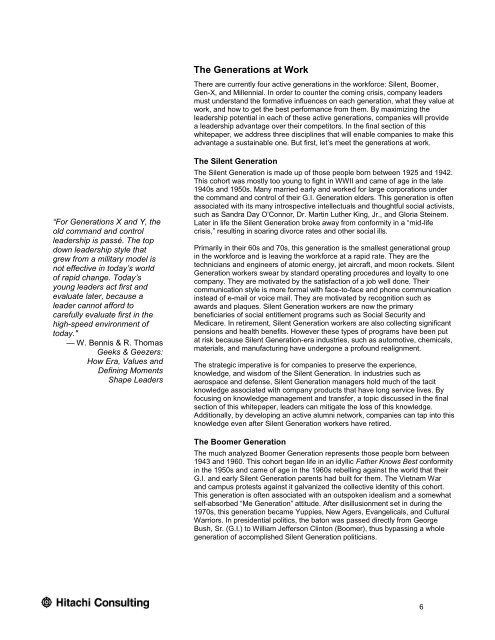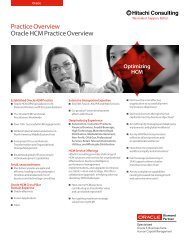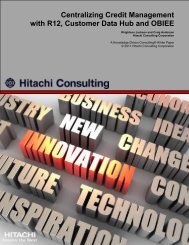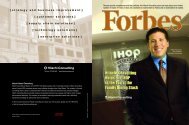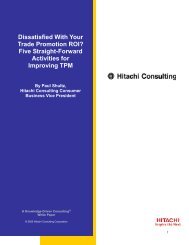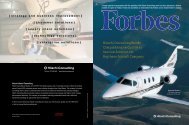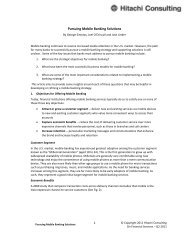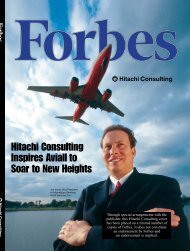Workforce Transformation: - Hitachi Consulting
Workforce Transformation: - Hitachi Consulting
Workforce Transformation: - Hitachi Consulting
Create successful ePaper yourself
Turn your PDF publications into a flip-book with our unique Google optimized e-Paper software.
―For Generations X and Y, the<br />
old command and control<br />
leadership is passé. The top<br />
down leadership style that<br />
grew from a military model is<br />
not effective in today’s world<br />
of rapid change. Today’s<br />
young leaders act first and<br />
evaluate later, because a<br />
leader cannot afford to<br />
carefully evaluate first in the<br />
high-speed environment of<br />
today."<br />
— W. Bennis & R. Thomas<br />
Geeks & Geezers:<br />
How Era, Values and<br />
Defining Moments<br />
Shape Leaders<br />
The Generations at Work<br />
There are currently four active generations in the workforce: Silent, Boomer,<br />
Gen-X, and Millennial. In order to counter the coming crisis, company leaders<br />
must understand the formative influences on each generation, what they value at<br />
work, and how to get the best performance from them. By maximizing the<br />
leadership potential in each of these active generations, companies will provide<br />
a leadership advantage over their competitors. In the final section of this<br />
whitepaper, we address three disciplines that will enable companies to make this<br />
advantage a sustainable one. But first, let’s meet the generations at work.<br />
The Silent Generation<br />
The Silent Generation is made up of those people born between 1925 and 1942.<br />
This cohort was mostly too young to fight in WWII and came of age in the late<br />
1940s and 1950s. Many married early and worked for large corporations under<br />
the command and control of their G.I. Generation elders. This generation is often<br />
associated with its many introspective intellectuals and thoughtful social activists,<br />
such as Sandra Day O’Connor, Dr. Martin Luther King, Jr., and Gloria Steinem.<br />
Later in life the Silent Generation broke away from conformity in a “mid-life<br />
crisis,” resulting in soaring divorce rates and other social ills.<br />
Primarily in their 60s and 70s, this generation is the smallest generational group<br />
in the workforce and is leaving the workforce at a rapid rate. They are the<br />
technicians and engineers of atomic energy, jet aircraft, and moon rockets. Silent<br />
Generation workers swear by standard operating procedures and loyalty to one<br />
company. They are motivated by the satisfaction of a job well done. Their<br />
communication style is more formal with face-to-face and phone communication<br />
instead of e-mail or voice mail. They are motivated by recognition such as<br />
awards and plaques. Silent Generation workers are now the primary<br />
beneficiaries of social entitlement programs such as Social Security and<br />
Medicare. In retirement, Silent Generation workers are also collecting significant<br />
pensions and health benefits. However these types of programs have been put<br />
at risk because Silent Generation-era industries, such as automotive, chemicals,<br />
materials, and manufacturing have undergone a profound realignment.<br />
The strategic imperative is for companies to preserve the experience,<br />
knowledge, and wisdom of the Silent Generation. In industries such as<br />
aerospace and defense, Silent Generation managers hold much of the tacit<br />
knowledge associated with company products that have long service lives. By<br />
focusing on knowledge management and transfer, a topic discussed in the final<br />
section of this whitepaper, leaders can mitigate the loss of this knowledge.<br />
Additionally, by developing an active alumni network, companies can tap into this<br />
knowledge even after Silent Generation workers have retired.<br />
The Boomer Generation<br />
The much analyzed Boomer Generation represents those people born between<br />
1943 and 1960. This cohort began life in an idyllic Father Knows Best conformity<br />
in the 1950s and came of age in the 1960s rebelling against the world that their<br />
G.I. and early Silent Generation parents had built for them. The Vietnam War<br />
and campus protests against it galvanized the collective identity of this cohort.<br />
This generation is often associated with an outspoken idealism and a somewhat<br />
self-absorbed “Me Generation” attitude. After disillusionment set in during the<br />
1970s, this generation became Yuppies, New Agers, Evangelicals, and Cultural<br />
Warriors. In presidential politics, the baton was passed directly from George<br />
Bush, Sr. (G.I.) to William Jefferson Clinton (Boomer), thus bypassing a whole<br />
generation of accomplished Silent Generation politicians.<br />
6


